Economic Impact of Tourism: A Report on Clipper Bay's Revival
VerifiedAdded on 2019/11/08
|13
|3753
|213
Report
AI Summary
This report analyzes the potential for economic revitalization in Clipper Bay, a small coastal community, through the development of its tourism sector. It begins with an introduction to Clipper Bay and its current economic reliance on fishing, then explores a development approach focused on eco-tourism and entertainment, supported by cost-benefit analysis considering factors like ease of access, labor pool, and resource availability. The report emphasizes a sustainable, responsible tourism approach involving stakeholders like local businesses, government, and tourists. An infrastructure plan, incorporating a Geographic Information System (GIS), is proposed, along with enhancements to superstructure elements. The analysis of economic, socio-cultural, and environmental factors highlights both advantages and disadvantages, such as employment opportunities and potential inflation. The report also includes a discussion of various stakeholders and their roles in the tourism industry.
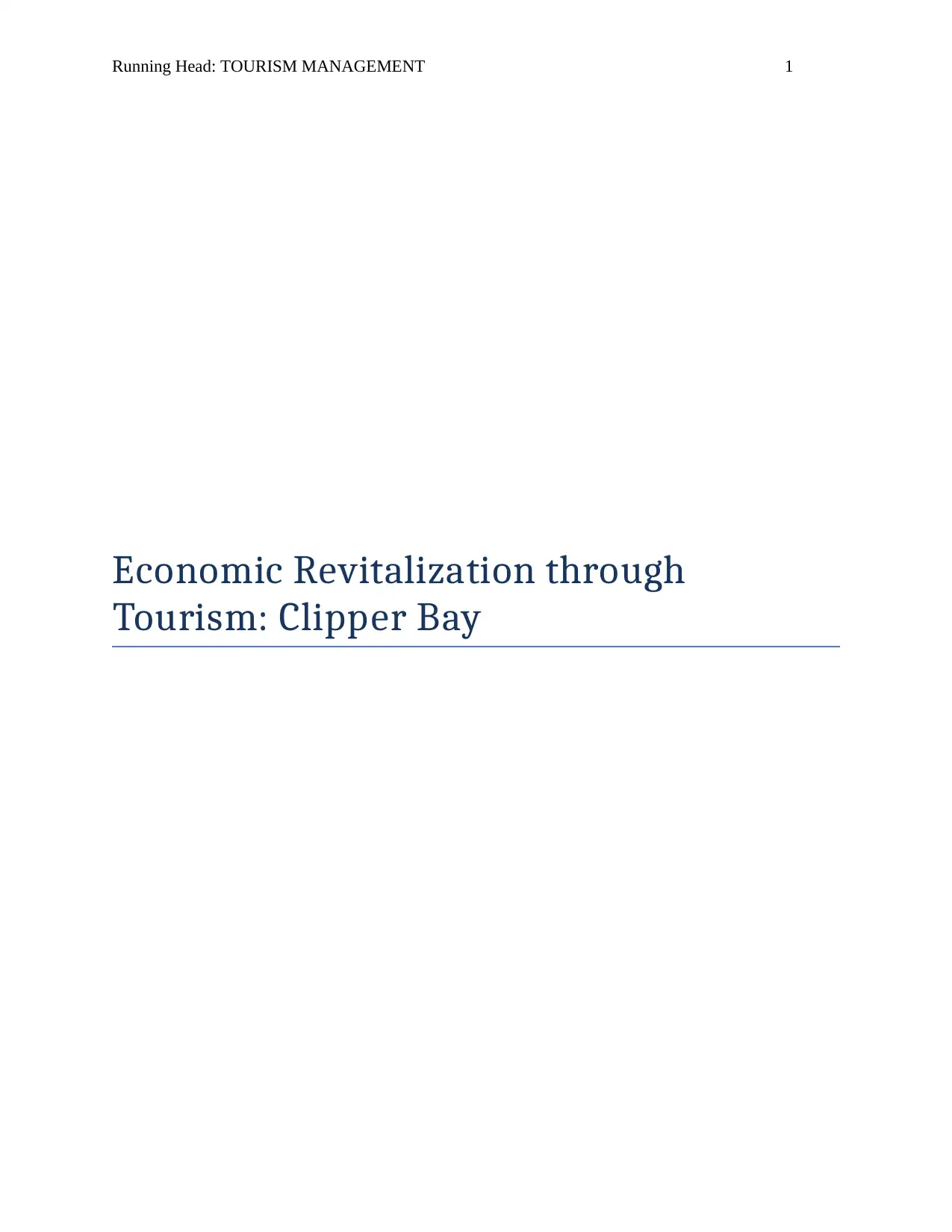
Running Head: TOURISM MANAGEMENT 1
Economic Revitalization through
Tourism: Clipper Bay
Economic Revitalization through
Tourism: Clipper Bay
Paraphrase This Document
Need a fresh take? Get an instant paraphrase of this document with our AI Paraphraser
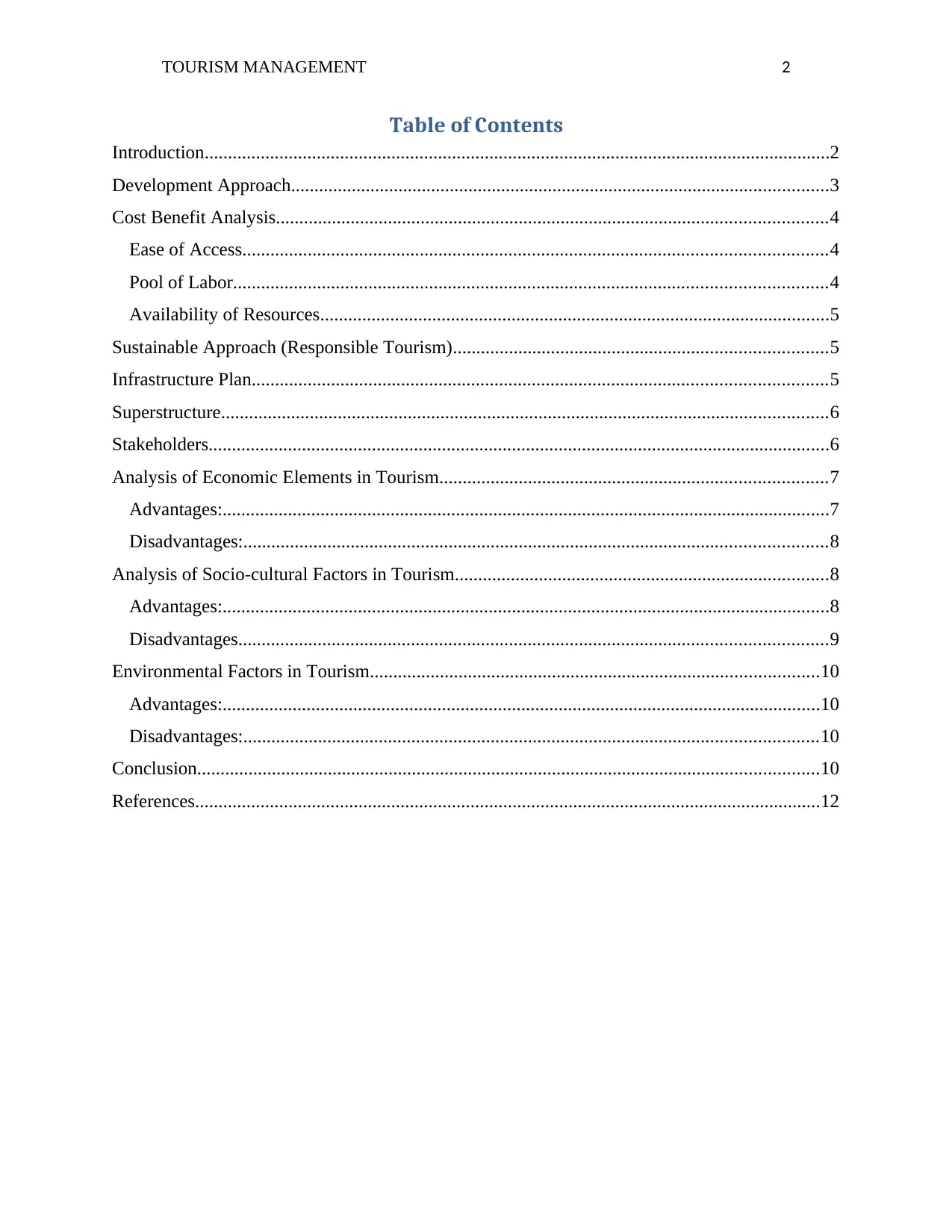
TOURISM MANAGEMENT 2
Table of Contents
Introduction......................................................................................................................................2
Development Approach...................................................................................................................3
Cost Benefit Analysis......................................................................................................................4
Ease of Access.............................................................................................................................4
Pool of Labor...............................................................................................................................4
Availability of Resources.............................................................................................................5
Sustainable Approach (Responsible Tourism)................................................................................5
Infrastructure Plan...........................................................................................................................5
Superstructure..................................................................................................................................6
Stakeholders.....................................................................................................................................6
Analysis of Economic Elements in Tourism...................................................................................7
Advantages:..................................................................................................................................7
Disadvantages:.............................................................................................................................8
Analysis of Socio-cultural Factors in Tourism................................................................................8
Advantages:..................................................................................................................................8
Disadvantages..............................................................................................................................9
Environmental Factors in Tourism................................................................................................10
Advantages:................................................................................................................................10
Disadvantages:...........................................................................................................................10
Conclusion.....................................................................................................................................10
References......................................................................................................................................12
Table of Contents
Introduction......................................................................................................................................2
Development Approach...................................................................................................................3
Cost Benefit Analysis......................................................................................................................4
Ease of Access.............................................................................................................................4
Pool of Labor...............................................................................................................................4
Availability of Resources.............................................................................................................5
Sustainable Approach (Responsible Tourism)................................................................................5
Infrastructure Plan...........................................................................................................................5
Superstructure..................................................................................................................................6
Stakeholders.....................................................................................................................................6
Analysis of Economic Elements in Tourism...................................................................................7
Advantages:..................................................................................................................................7
Disadvantages:.............................................................................................................................8
Analysis of Socio-cultural Factors in Tourism................................................................................8
Advantages:..................................................................................................................................8
Disadvantages..............................................................................................................................9
Environmental Factors in Tourism................................................................................................10
Advantages:................................................................................................................................10
Disadvantages:...........................................................................................................................10
Conclusion.....................................................................................................................................10
References......................................................................................................................................12
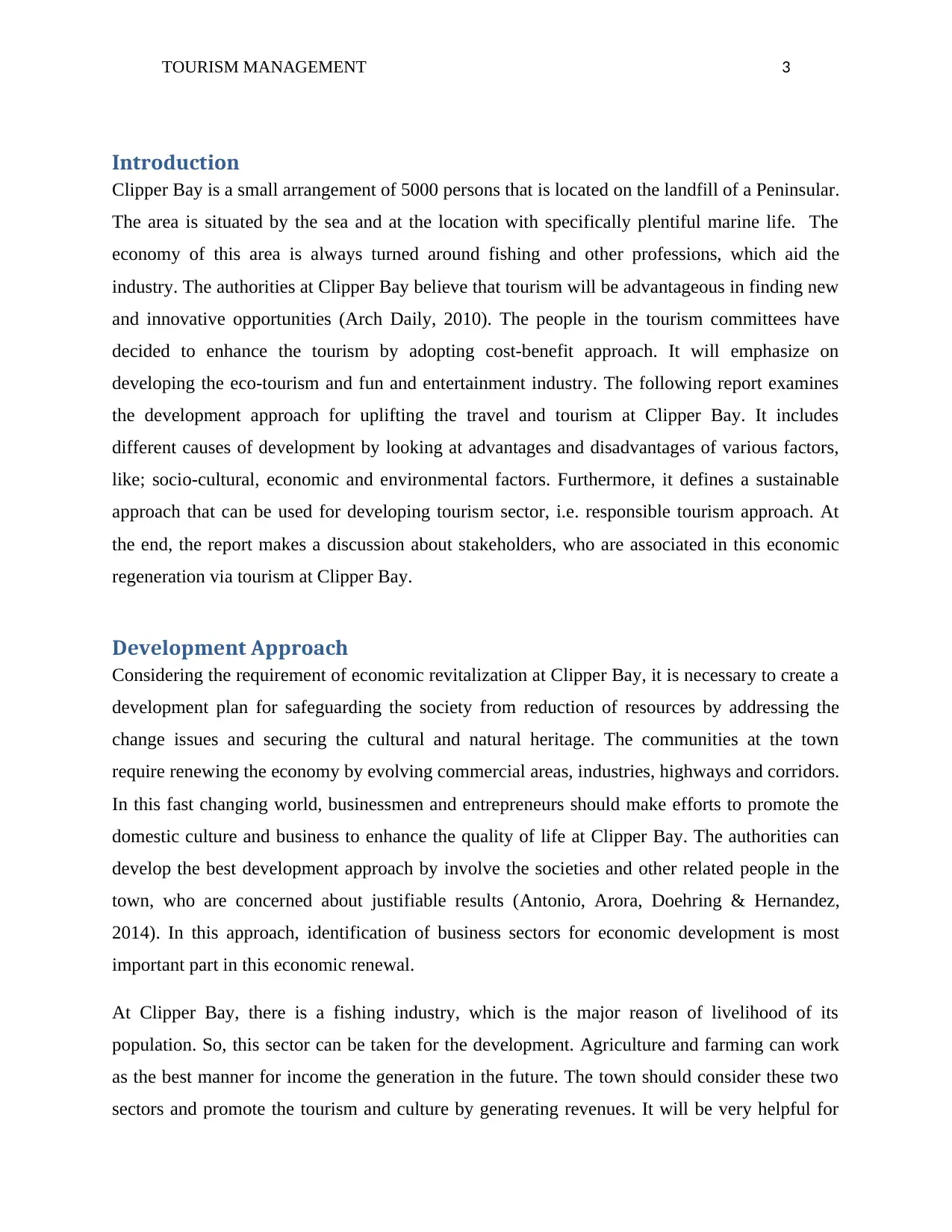
TOURISM MANAGEMENT 3
Introduction
Clipper Bay is a small arrangement of 5000 persons that is located on the landfill of a Peninsular.
The area is situated by the sea and at the location with specifically plentiful marine life. The
economy of this area is always turned around fishing and other professions, which aid the
industry. The authorities at Clipper Bay believe that tourism will be advantageous in finding new
and innovative opportunities (Arch Daily, 2010). The people in the tourism committees have
decided to enhance the tourism by adopting cost-benefit approach. It will emphasize on
developing the eco-tourism and fun and entertainment industry. The following report examines
the development approach for uplifting the travel and tourism at Clipper Bay. It includes
different causes of development by looking at advantages and disadvantages of various factors,
like; socio-cultural, economic and environmental factors. Furthermore, it defines a sustainable
approach that can be used for developing tourism sector, i.e. responsible tourism approach. At
the end, the report makes a discussion about stakeholders, who are associated in this economic
regeneration via tourism at Clipper Bay.
Development Approach
Considering the requirement of economic revitalization at Clipper Bay, it is necessary to create a
development plan for safeguarding the society from reduction of resources by addressing the
change issues and securing the cultural and natural heritage. The communities at the town
require renewing the economy by evolving commercial areas, industries, highways and corridors.
In this fast changing world, businessmen and entrepreneurs should make efforts to promote the
domestic culture and business to enhance the quality of life at Clipper Bay. The authorities can
develop the best development approach by involve the societies and other related people in the
town, who are concerned about justifiable results (Antonio, Arora, Doehring & Hernandez,
2014). In this approach, identification of business sectors for economic development is most
important part in this economic renewal.
At Clipper Bay, there is a fishing industry, which is the major reason of livelihood of its
population. So, this sector can be taken for the development. Agriculture and farming can work
as the best manner for income the generation in the future. The town should consider these two
sectors and promote the tourism and culture by generating revenues. It will be very helpful for
Introduction
Clipper Bay is a small arrangement of 5000 persons that is located on the landfill of a Peninsular.
The area is situated by the sea and at the location with specifically plentiful marine life. The
economy of this area is always turned around fishing and other professions, which aid the
industry. The authorities at Clipper Bay believe that tourism will be advantageous in finding new
and innovative opportunities (Arch Daily, 2010). The people in the tourism committees have
decided to enhance the tourism by adopting cost-benefit approach. It will emphasize on
developing the eco-tourism and fun and entertainment industry. The following report examines
the development approach for uplifting the travel and tourism at Clipper Bay. It includes
different causes of development by looking at advantages and disadvantages of various factors,
like; socio-cultural, economic and environmental factors. Furthermore, it defines a sustainable
approach that can be used for developing tourism sector, i.e. responsible tourism approach. At
the end, the report makes a discussion about stakeholders, who are associated in this economic
regeneration via tourism at Clipper Bay.
Development Approach
Considering the requirement of economic revitalization at Clipper Bay, it is necessary to create a
development plan for safeguarding the society from reduction of resources by addressing the
change issues and securing the cultural and natural heritage. The communities at the town
require renewing the economy by evolving commercial areas, industries, highways and corridors.
In this fast changing world, businessmen and entrepreneurs should make efforts to promote the
domestic culture and business to enhance the quality of life at Clipper Bay. The authorities can
develop the best development approach by involve the societies and other related people in the
town, who are concerned about justifiable results (Antonio, Arora, Doehring & Hernandez,
2014). In this approach, identification of business sectors for economic development is most
important part in this economic renewal.
At Clipper Bay, there is a fishing industry, which is the major reason of livelihood of its
population. So, this sector can be taken for the development. Agriculture and farming can work
as the best manner for income the generation in the future. The town should consider these two
sectors and promote the tourism and culture by generating revenues. It will be very helpful for
⊘ This is a preview!⊘
Do you want full access?
Subscribe today to unlock all pages.

Trusted by 1+ million students worldwide
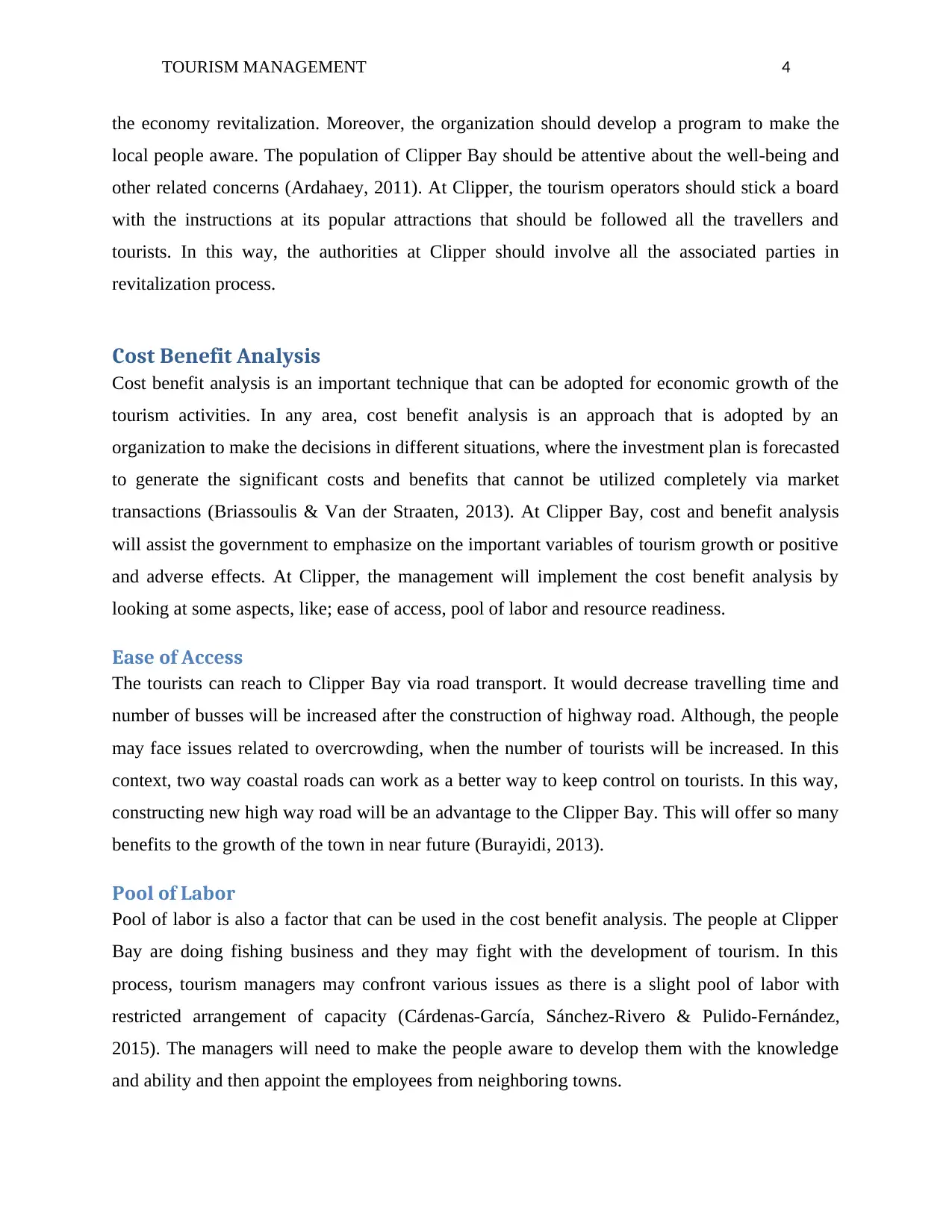
TOURISM MANAGEMENT 4
the economy revitalization. Moreover, the organization should develop a program to make the
local people aware. The population of Clipper Bay should be attentive about the well-being and
other related concerns (Ardahaey, 2011). At Clipper, the tourism operators should stick a board
with the instructions at its popular attractions that should be followed all the travellers and
tourists. In this way, the authorities at Clipper should involve all the associated parties in
revitalization process.
Cost Benefit Analysis
Cost benefit analysis is an important technique that can be adopted for economic growth of the
tourism activities. In any area, cost benefit analysis is an approach that is adopted by an
organization to make the decisions in different situations, where the investment plan is forecasted
to generate the significant costs and benefits that cannot be utilized completely via market
transactions (Briassoulis & Van der Straaten, 2013). At Clipper Bay, cost and benefit analysis
will assist the government to emphasize on the important variables of tourism growth or positive
and adverse effects. At Clipper, the management will implement the cost benefit analysis by
looking at some aspects, like; ease of access, pool of labor and resource readiness.
Ease of Access
The tourists can reach to Clipper Bay via road transport. It would decrease travelling time and
number of busses will be increased after the construction of highway road. Although, the people
may face issues related to overcrowding, when the number of tourists will be increased. In this
context, two way coastal roads can work as a better way to keep control on tourists. In this way,
constructing new high way road will be an advantage to the Clipper Bay. This will offer so many
benefits to the growth of the town in near future (Burayidi, 2013).
Pool of Labor
Pool of labor is also a factor that can be used in the cost benefit analysis. The people at Clipper
Bay are doing fishing business and they may fight with the development of tourism. In this
process, tourism managers may confront various issues as there is a slight pool of labor with
restricted arrangement of capacity (Cárdenas-García, Sánchez-Rivero & Pulido-Fernández,
2015). The managers will need to make the people aware to develop them with the knowledge
and ability and then appoint the employees from neighboring towns.
the economy revitalization. Moreover, the organization should develop a program to make the
local people aware. The population of Clipper Bay should be attentive about the well-being and
other related concerns (Ardahaey, 2011). At Clipper, the tourism operators should stick a board
with the instructions at its popular attractions that should be followed all the travellers and
tourists. In this way, the authorities at Clipper should involve all the associated parties in
revitalization process.
Cost Benefit Analysis
Cost benefit analysis is an important technique that can be adopted for economic growth of the
tourism activities. In any area, cost benefit analysis is an approach that is adopted by an
organization to make the decisions in different situations, where the investment plan is forecasted
to generate the significant costs and benefits that cannot be utilized completely via market
transactions (Briassoulis & Van der Straaten, 2013). At Clipper Bay, cost and benefit analysis
will assist the government to emphasize on the important variables of tourism growth or positive
and adverse effects. At Clipper, the management will implement the cost benefit analysis by
looking at some aspects, like; ease of access, pool of labor and resource readiness.
Ease of Access
The tourists can reach to Clipper Bay via road transport. It would decrease travelling time and
number of busses will be increased after the construction of highway road. Although, the people
may face issues related to overcrowding, when the number of tourists will be increased. In this
context, two way coastal roads can work as a better way to keep control on tourists. In this way,
constructing new high way road will be an advantage to the Clipper Bay. This will offer so many
benefits to the growth of the town in near future (Burayidi, 2013).
Pool of Labor
Pool of labor is also a factor that can be used in the cost benefit analysis. The people at Clipper
Bay are doing fishing business and they may fight with the development of tourism. In this
process, tourism managers may confront various issues as there is a slight pool of labor with
restricted arrangement of capacity (Cárdenas-García, Sánchez-Rivero & Pulido-Fernández,
2015). The managers will need to make the people aware to develop them with the knowledge
and ability and then appoint the employees from neighboring towns.
Paraphrase This Document
Need a fresh take? Get an instant paraphrase of this document with our AI Paraphraser
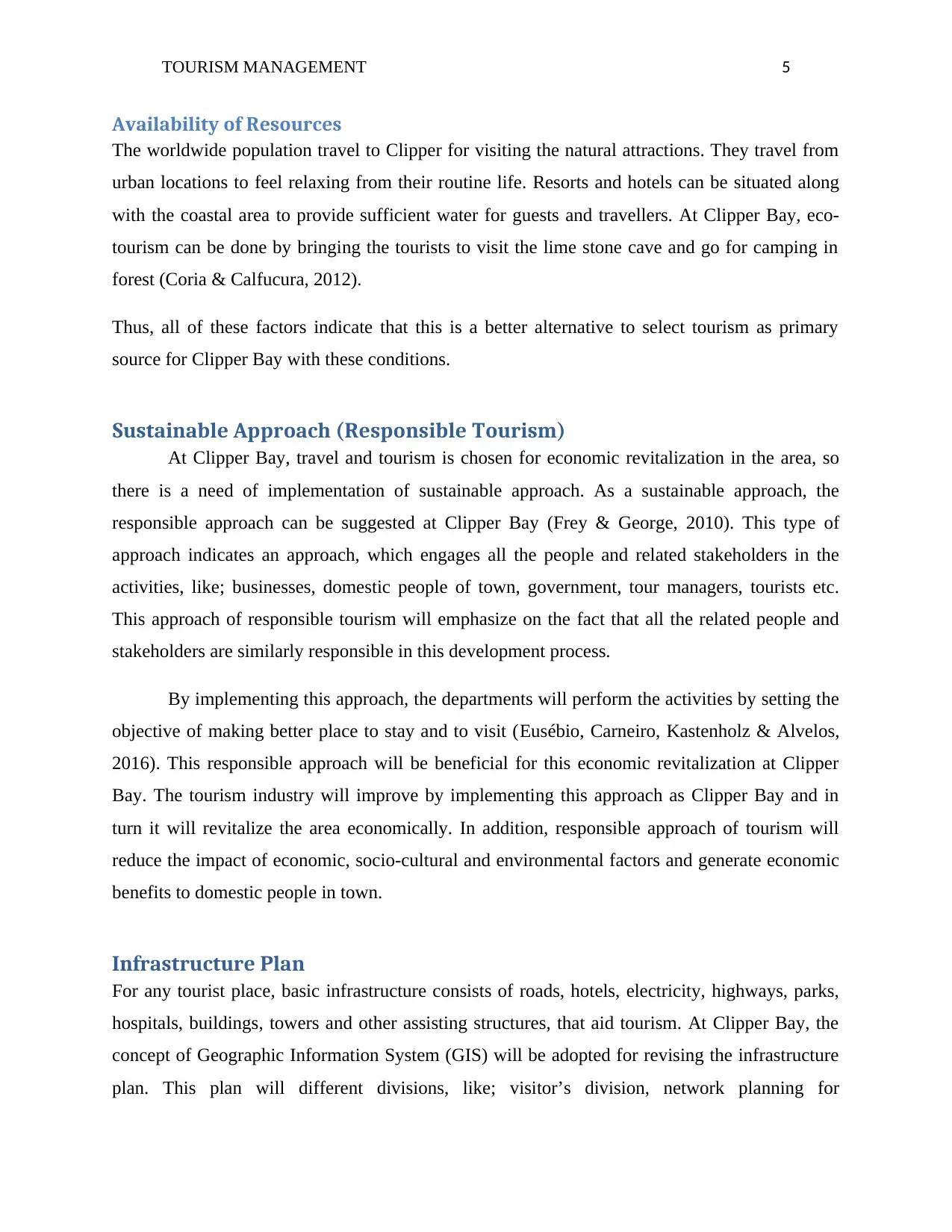
TOURISM MANAGEMENT 5
Availability of Resources
The worldwide population travel to Clipper for visiting the natural attractions. They travel from
urban locations to feel relaxing from their routine life. Resorts and hotels can be situated along
with the coastal area to provide sufficient water for guests and travellers. At Clipper Bay, eco-
tourism can be done by bringing the tourists to visit the lime stone cave and go for camping in
forest (Coria & Calfucura, 2012).
Thus, all of these factors indicate that this is a better alternative to select tourism as primary
source for Clipper Bay with these conditions.
Sustainable Approach (Responsible Tourism)
At Clipper Bay, travel and tourism is chosen for economic revitalization in the area, so
there is a need of implementation of sustainable approach. As a sustainable approach, the
responsible approach can be suggested at Clipper Bay (Frey & George, 2010). This type of
approach indicates an approach, which engages all the people and related stakeholders in the
activities, like; businesses, domestic people of town, government, tour managers, tourists etc.
This approach of responsible tourism will emphasize on the fact that all the related people and
stakeholders are similarly responsible in this development process.
By implementing this approach, the departments will perform the activities by setting the
objective of making better place to stay and to visit (Eusébio, Carneiro, Kastenholz & Alvelos,
2016). This responsible approach will be beneficial for this economic revitalization at Clipper
Bay. The tourism industry will improve by implementing this approach as Clipper Bay and in
turn it will revitalize the area economically. In addition, responsible approach of tourism will
reduce the impact of economic, socio-cultural and environmental factors and generate economic
benefits to domestic people in town.
Infrastructure Plan
For any tourist place, basic infrastructure consists of roads, hotels, electricity, highways, parks,
hospitals, buildings, towers and other assisting structures, that aid tourism. At Clipper Bay, the
concept of Geographic Information System (GIS) will be adopted for revising the infrastructure
plan. This plan will different divisions, like; visitor’s division, network planning for
Availability of Resources
The worldwide population travel to Clipper for visiting the natural attractions. They travel from
urban locations to feel relaxing from their routine life. Resorts and hotels can be situated along
with the coastal area to provide sufficient water for guests and travellers. At Clipper Bay, eco-
tourism can be done by bringing the tourists to visit the lime stone cave and go for camping in
forest (Coria & Calfucura, 2012).
Thus, all of these factors indicate that this is a better alternative to select tourism as primary
source for Clipper Bay with these conditions.
Sustainable Approach (Responsible Tourism)
At Clipper Bay, travel and tourism is chosen for economic revitalization in the area, so
there is a need of implementation of sustainable approach. As a sustainable approach, the
responsible approach can be suggested at Clipper Bay (Frey & George, 2010). This type of
approach indicates an approach, which engages all the people and related stakeholders in the
activities, like; businesses, domestic people of town, government, tour managers, tourists etc.
This approach of responsible tourism will emphasize on the fact that all the related people and
stakeholders are similarly responsible in this development process.
By implementing this approach, the departments will perform the activities by setting the
objective of making better place to stay and to visit (Eusébio, Carneiro, Kastenholz & Alvelos,
2016). This responsible approach will be beneficial for this economic revitalization at Clipper
Bay. The tourism industry will improve by implementing this approach as Clipper Bay and in
turn it will revitalize the area economically. In addition, responsible approach of tourism will
reduce the impact of economic, socio-cultural and environmental factors and generate economic
benefits to domestic people in town.
Infrastructure Plan
For any tourist place, basic infrastructure consists of roads, hotels, electricity, highways, parks,
hospitals, buildings, towers and other assisting structures, that aid tourism. At Clipper Bay, the
concept of Geographic Information System (GIS) will be adopted for revising the infrastructure
plan. This plan will different divisions, like; visitor’s division, network planning for
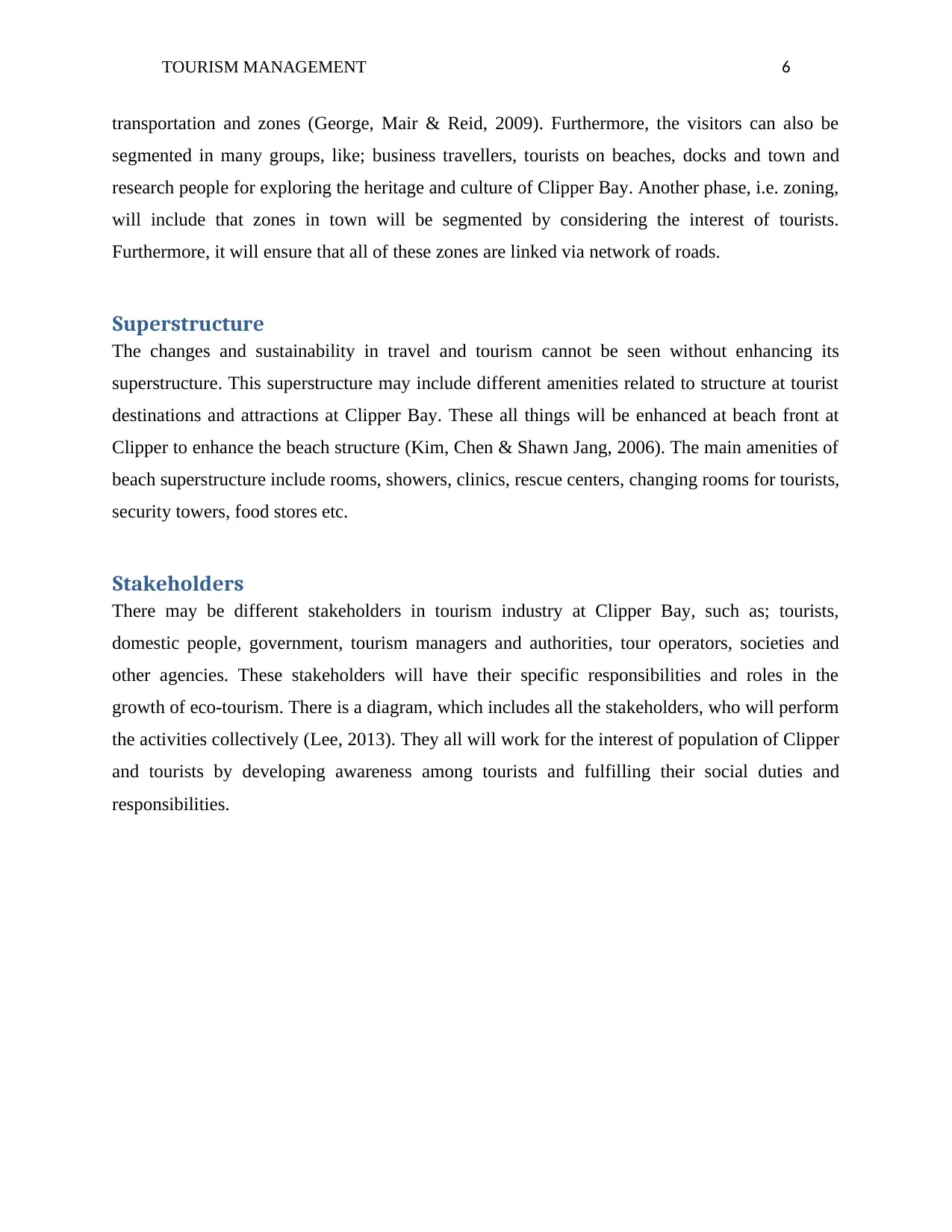
TOURISM MANAGEMENT 6
transportation and zones (George, Mair & Reid, 2009). Furthermore, the visitors can also be
segmented in many groups, like; business travellers, tourists on beaches, docks and town and
research people for exploring the heritage and culture of Clipper Bay. Another phase, i.e. zoning,
will include that zones in town will be segmented by considering the interest of tourists.
Furthermore, it will ensure that all of these zones are linked via network of roads.
Superstructure
The changes and sustainability in travel and tourism cannot be seen without enhancing its
superstructure. This superstructure may include different amenities related to structure at tourist
destinations and attractions at Clipper Bay. These all things will be enhanced at beach front at
Clipper to enhance the beach structure (Kim, Chen & Shawn Jang, 2006). The main amenities of
beach superstructure include rooms, showers, clinics, rescue centers, changing rooms for tourists,
security towers, food stores etc.
Stakeholders
There may be different stakeholders in tourism industry at Clipper Bay, such as; tourists,
domestic people, government, tourism managers and authorities, tour operators, societies and
other agencies. These stakeholders will have their specific responsibilities and roles in the
growth of eco-tourism. There is a diagram, which includes all the stakeholders, who will perform
the activities collectively (Lee, 2013). They all will work for the interest of population of Clipper
and tourists by developing awareness among tourists and fulfilling their social duties and
responsibilities.
transportation and zones (George, Mair & Reid, 2009). Furthermore, the visitors can also be
segmented in many groups, like; business travellers, tourists on beaches, docks and town and
research people for exploring the heritage and culture of Clipper Bay. Another phase, i.e. zoning,
will include that zones in town will be segmented by considering the interest of tourists.
Furthermore, it will ensure that all of these zones are linked via network of roads.
Superstructure
The changes and sustainability in travel and tourism cannot be seen without enhancing its
superstructure. This superstructure may include different amenities related to structure at tourist
destinations and attractions at Clipper Bay. These all things will be enhanced at beach front at
Clipper to enhance the beach structure (Kim, Chen & Shawn Jang, 2006). The main amenities of
beach superstructure include rooms, showers, clinics, rescue centers, changing rooms for tourists,
security towers, food stores etc.
Stakeholders
There may be different stakeholders in tourism industry at Clipper Bay, such as; tourists,
domestic people, government, tourism managers and authorities, tour operators, societies and
other agencies. These stakeholders will have their specific responsibilities and roles in the
growth of eco-tourism. There is a diagram, which includes all the stakeholders, who will perform
the activities collectively (Lee, 2013). They all will work for the interest of population of Clipper
and tourists by developing awareness among tourists and fulfilling their social duties and
responsibilities.
⊘ This is a preview!⊘
Do you want full access?
Subscribe today to unlock all pages.

Trusted by 1+ million students worldwide
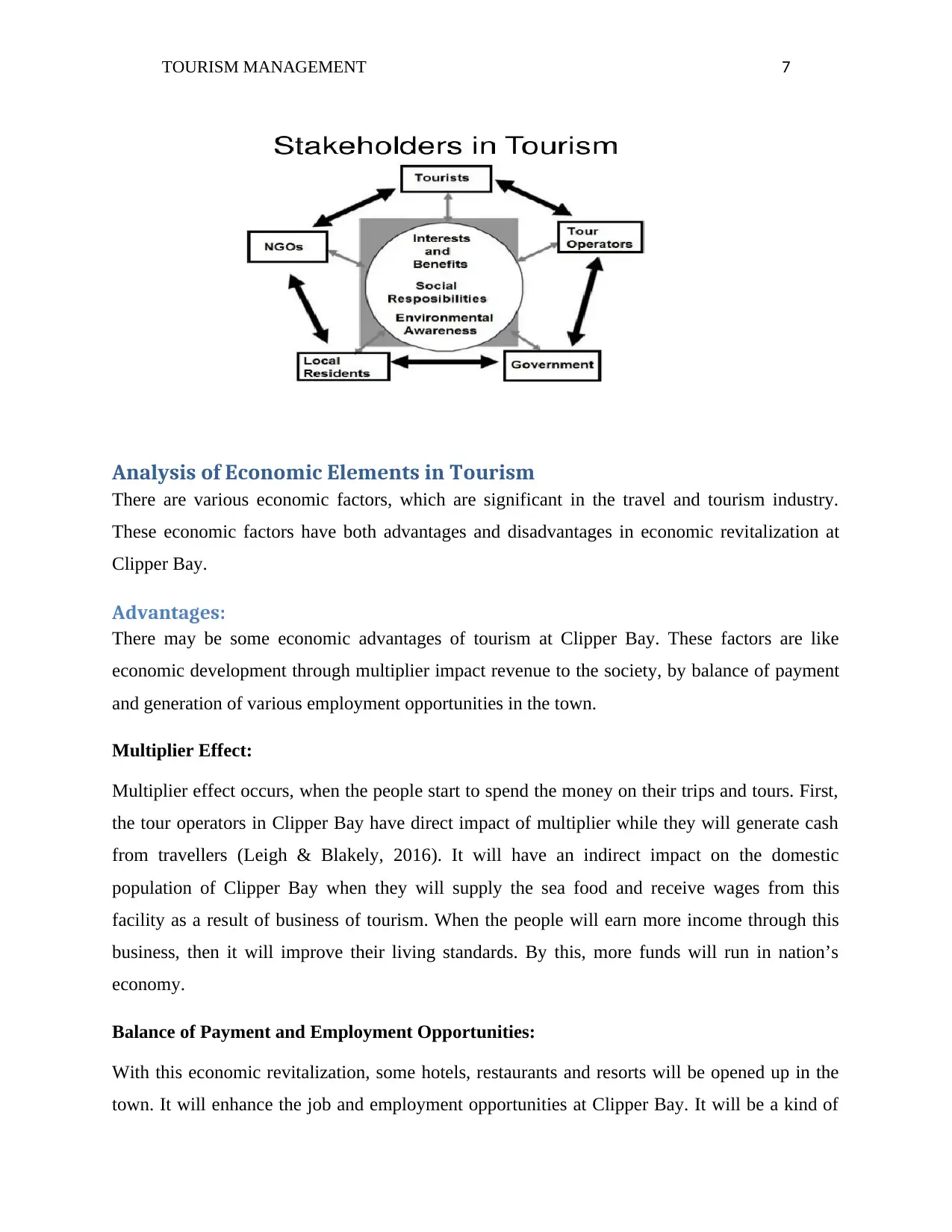
TOURISM MANAGEMENT 7
Analysis of Economic Elements in Tourism
There are various economic factors, which are significant in the travel and tourism industry.
These economic factors have both advantages and disadvantages in economic revitalization at
Clipper Bay.
Advantages:
There may be some economic advantages of tourism at Clipper Bay. These factors are like
economic development through multiplier impact revenue to the society, by balance of payment
and generation of various employment opportunities in the town.
Multiplier Effect:
Multiplier effect occurs, when the people start to spend the money on their trips and tours. First,
the tour operators in Clipper Bay have direct impact of multiplier while they will generate cash
from travellers (Leigh & Blakely, 2016). It will have an indirect impact on the domestic
population of Clipper Bay when they will supply the sea food and receive wages from this
facility as a result of business of tourism. When the people will earn more income through this
business, then it will improve their living standards. By this, more funds will run in nation’s
economy.
Balance of Payment and Employment Opportunities:
With this economic revitalization, some hotels, restaurants and resorts will be opened up in the
town. It will enhance the job and employment opportunities at Clipper Bay. It will be a kind of
Analysis of Economic Elements in Tourism
There are various economic factors, which are significant in the travel and tourism industry.
These economic factors have both advantages and disadvantages in economic revitalization at
Clipper Bay.
Advantages:
There may be some economic advantages of tourism at Clipper Bay. These factors are like
economic development through multiplier impact revenue to the society, by balance of payment
and generation of various employment opportunities in the town.
Multiplier Effect:
Multiplier effect occurs, when the people start to spend the money on their trips and tours. First,
the tour operators in Clipper Bay have direct impact of multiplier while they will generate cash
from travellers (Leigh & Blakely, 2016). It will have an indirect impact on the domestic
population of Clipper Bay when they will supply the sea food and receive wages from this
facility as a result of business of tourism. When the people will earn more income through this
business, then it will improve their living standards. By this, more funds will run in nation’s
economy.
Balance of Payment and Employment Opportunities:
With this economic revitalization, some hotels, restaurants and resorts will be opened up in the
town. It will enhance the job and employment opportunities at Clipper Bay. It will be a kind of
Paraphrase This Document
Need a fresh take? Get an instant paraphrase of this document with our AI Paraphraser
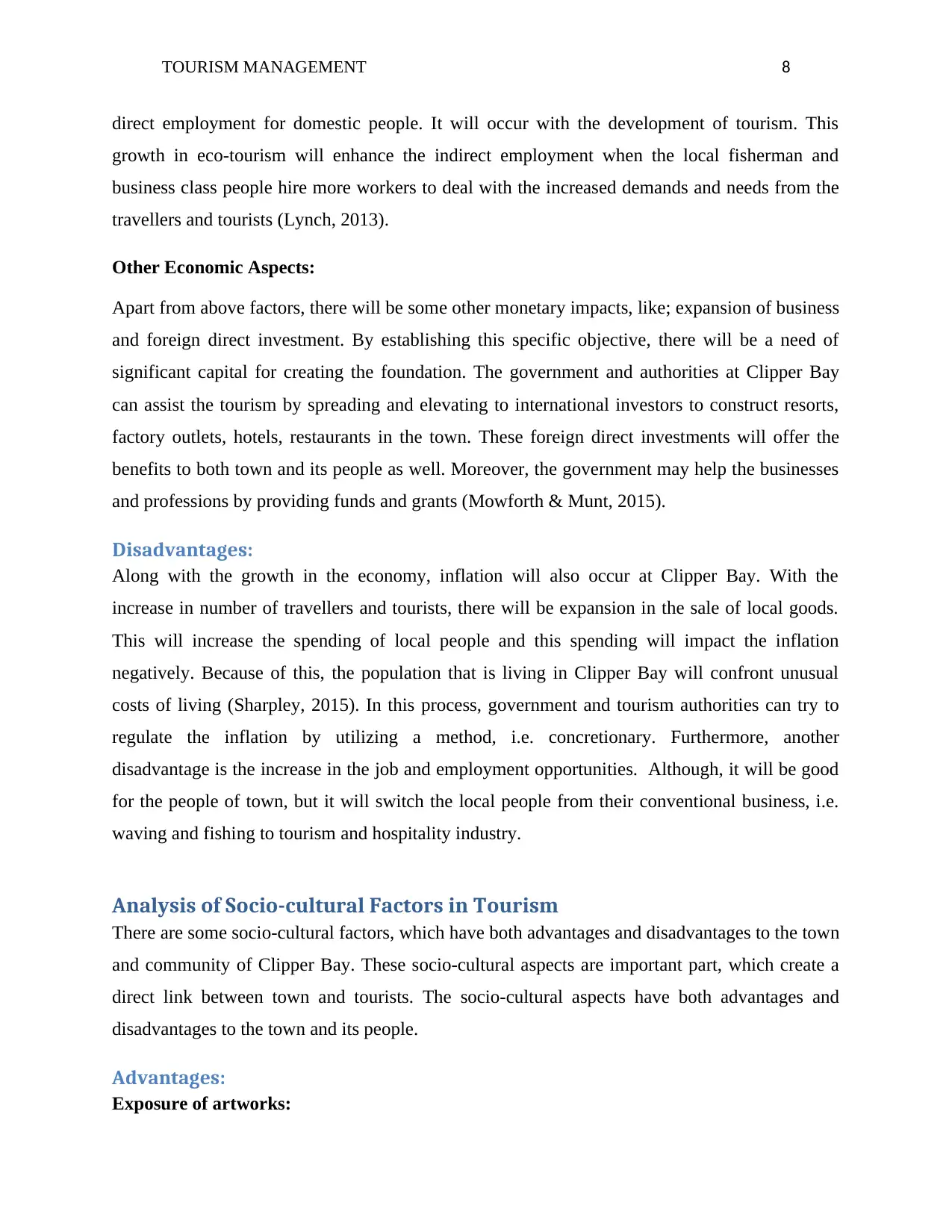
TOURISM MANAGEMENT 8
direct employment for domestic people. It will occur with the development of tourism. This
growth in eco-tourism will enhance the indirect employment when the local fisherman and
business class people hire more workers to deal with the increased demands and needs from the
travellers and tourists (Lynch, 2013).
Other Economic Aspects:
Apart from above factors, there will be some other monetary impacts, like; expansion of business
and foreign direct investment. By establishing this specific objective, there will be a need of
significant capital for creating the foundation. The government and authorities at Clipper Bay
can assist the tourism by spreading and elevating to international investors to construct resorts,
factory outlets, hotels, restaurants in the town. These foreign direct investments will offer the
benefits to both town and its people as well. Moreover, the government may help the businesses
and professions by providing funds and grants (Mowforth & Munt, 2015).
Disadvantages:
Along with the growth in the economy, inflation will also occur at Clipper Bay. With the
increase in number of travellers and tourists, there will be expansion in the sale of local goods.
This will increase the spending of local people and this spending will impact the inflation
negatively. Because of this, the population that is living in Clipper Bay will confront unusual
costs of living (Sharpley, 2015). In this process, government and tourism authorities can try to
regulate the inflation by utilizing a method, i.e. concretionary. Furthermore, another
disadvantage is the increase in the job and employment opportunities. Although, it will be good
for the people of town, but it will switch the local people from their conventional business, i.e.
waving and fishing to tourism and hospitality industry.
Analysis of Socio-cultural Factors in Tourism
There are some socio-cultural factors, which have both advantages and disadvantages to the town
and community of Clipper Bay. These socio-cultural aspects are important part, which create a
direct link between town and tourists. The socio-cultural aspects have both advantages and
disadvantages to the town and its people.
Advantages:
Exposure of artworks:
direct employment for domestic people. It will occur with the development of tourism. This
growth in eco-tourism will enhance the indirect employment when the local fisherman and
business class people hire more workers to deal with the increased demands and needs from the
travellers and tourists (Lynch, 2013).
Other Economic Aspects:
Apart from above factors, there will be some other monetary impacts, like; expansion of business
and foreign direct investment. By establishing this specific objective, there will be a need of
significant capital for creating the foundation. The government and authorities at Clipper Bay
can assist the tourism by spreading and elevating to international investors to construct resorts,
factory outlets, hotels, restaurants in the town. These foreign direct investments will offer the
benefits to both town and its people as well. Moreover, the government may help the businesses
and professions by providing funds and grants (Mowforth & Munt, 2015).
Disadvantages:
Along with the growth in the economy, inflation will also occur at Clipper Bay. With the
increase in number of travellers and tourists, there will be expansion in the sale of local goods.
This will increase the spending of local people and this spending will impact the inflation
negatively. Because of this, the population that is living in Clipper Bay will confront unusual
costs of living (Sharpley, 2015). In this process, government and tourism authorities can try to
regulate the inflation by utilizing a method, i.e. concretionary. Furthermore, another
disadvantage is the increase in the job and employment opportunities. Although, it will be good
for the people of town, but it will switch the local people from their conventional business, i.e.
waving and fishing to tourism and hospitality industry.
Analysis of Socio-cultural Factors in Tourism
There are some socio-cultural factors, which have both advantages and disadvantages to the town
and community of Clipper Bay. These socio-cultural aspects are important part, which create a
direct link between town and tourists. The socio-cultural aspects have both advantages and
disadvantages to the town and its people.
Advantages:
Exposure of artworks:

TOURISM MANAGEMENT 9
The government should focus on the exposure of specialty and artworks of town. This exposure
will increase the travellers and visitors, who are travelling to Clipper Bay as there is direct
connection between domestic people and visitors. With this increased awareness,
commercialization of these artworks can occur (Sinclair-Maragh, Gursoy & Vieregge, 2015).
With this, the government can make focus on Clipper Bay with antique center to make it safe and
it will ensure that only domestic craft products will be sold at this antique center.
Safeguarding the heritage:
The government should make some changes in the rules and regulations at attractions. The
government can utilize the tax, which is collected from the visitors to build a gallery in the town
for tourists and youth generation, so that they can understand and mean the neighborhood social.
There will be an instructor to safeguard and protect the culture and heritage and ensuring that
there would not be pollution from vehicles, factories and industries.
Cross-Cultural Obligation:
When the number of tourists will increase in Clipper Bay, then local people can demonstrate
their own lifestyle. This will not only allow the tourists to understand the indigenous local people
bur also the people will be prepared to expand their mindfulness through becoming informal.
The domestic people will have the potential to have the benefit when any regular tourist begins
to involve and help them in their routine activities (Webster & Ivanov, 2014). They will make
efforts to revolutionize the tourism and incorporate new things from other tradition and culture.
Disadvantages
Apart from these advantages, there are some disadvantages of socio-cultural factors from tourism
at Clipper Bay. Because the people from different places and culture are arriving to Clipper Bay,
it will affect the youths for being beak free from their daily practices and works. It will lead to
the loss of custom in the town, as the local people will avoid the weaving and fishing business
for getting better jobs in the hotels and resorts. In this way, it will impact the traditional and
social segment of the town. In addition, there may be chances of moral disintegration, like;
consumption of alcohol and smoking that can influence the religion of Clipper Bay. Some other
disadvantages of these factors are that there will be scarcity of resources and assets because of
overcrowding in town (Woo, Kim & Uysal, 2015).
The government should focus on the exposure of specialty and artworks of town. This exposure
will increase the travellers and visitors, who are travelling to Clipper Bay as there is direct
connection between domestic people and visitors. With this increased awareness,
commercialization of these artworks can occur (Sinclair-Maragh, Gursoy & Vieregge, 2015).
With this, the government can make focus on Clipper Bay with antique center to make it safe and
it will ensure that only domestic craft products will be sold at this antique center.
Safeguarding the heritage:
The government should make some changes in the rules and regulations at attractions. The
government can utilize the tax, which is collected from the visitors to build a gallery in the town
for tourists and youth generation, so that they can understand and mean the neighborhood social.
There will be an instructor to safeguard and protect the culture and heritage and ensuring that
there would not be pollution from vehicles, factories and industries.
Cross-Cultural Obligation:
When the number of tourists will increase in Clipper Bay, then local people can demonstrate
their own lifestyle. This will not only allow the tourists to understand the indigenous local people
bur also the people will be prepared to expand their mindfulness through becoming informal.
The domestic people will have the potential to have the benefit when any regular tourist begins
to involve and help them in their routine activities (Webster & Ivanov, 2014). They will make
efforts to revolutionize the tourism and incorporate new things from other tradition and culture.
Disadvantages
Apart from these advantages, there are some disadvantages of socio-cultural factors from tourism
at Clipper Bay. Because the people from different places and culture are arriving to Clipper Bay,
it will affect the youths for being beak free from their daily practices and works. It will lead to
the loss of custom in the town, as the local people will avoid the weaving and fishing business
for getting better jobs in the hotels and resorts. In this way, it will impact the traditional and
social segment of the town. In addition, there may be chances of moral disintegration, like;
consumption of alcohol and smoking that can influence the religion of Clipper Bay. Some other
disadvantages of these factors are that there will be scarcity of resources and assets because of
overcrowding in town (Woo, Kim & Uysal, 2015).
⊘ This is a preview!⊘
Do you want full access?
Subscribe today to unlock all pages.

Trusted by 1+ million students worldwide
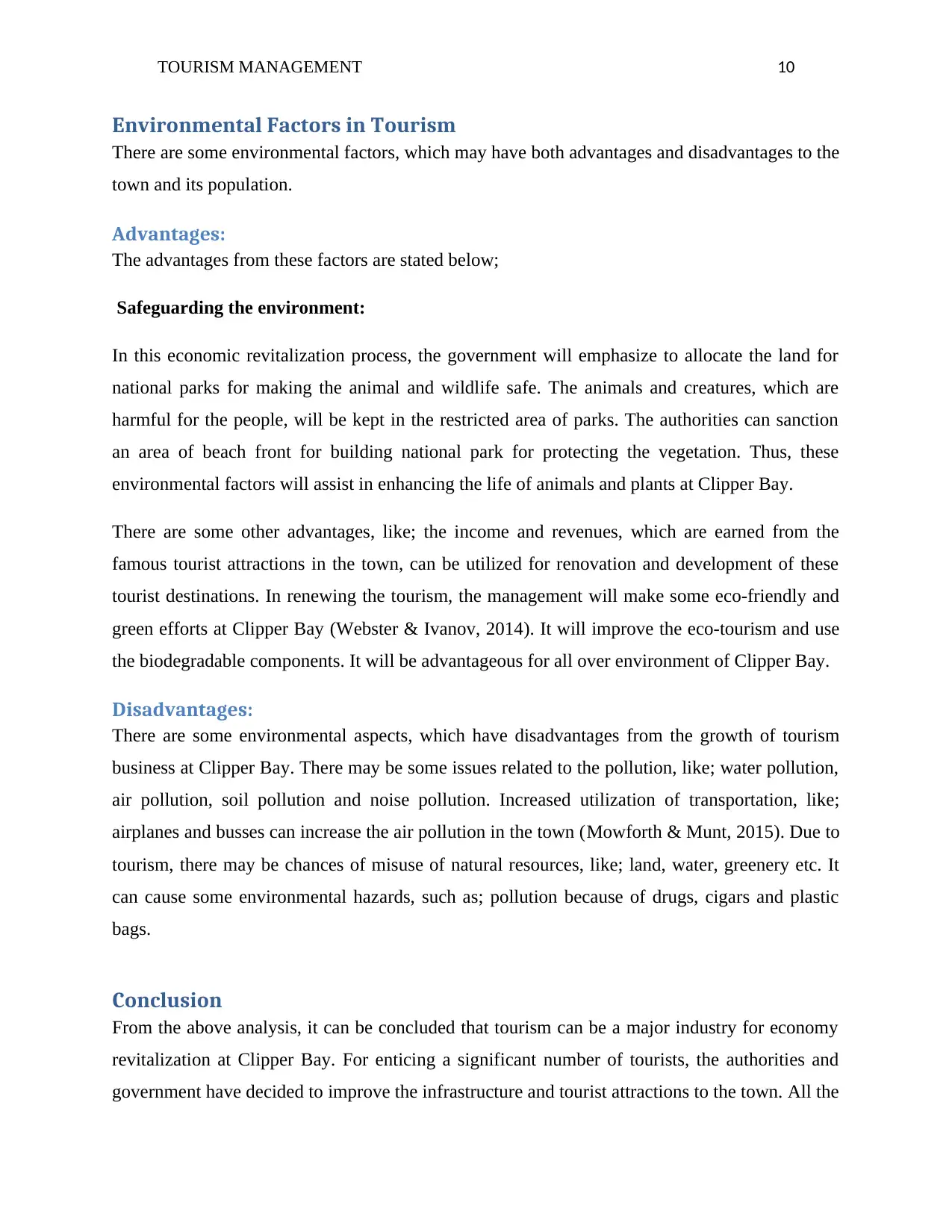
TOURISM MANAGEMENT 10
Environmental Factors in Tourism
There are some environmental factors, which may have both advantages and disadvantages to the
town and its population.
Advantages:
The advantages from these factors are stated below;
Safeguarding the environment:
In this economic revitalization process, the government will emphasize to allocate the land for
national parks for making the animal and wildlife safe. The animals and creatures, which are
harmful for the people, will be kept in the restricted area of parks. The authorities can sanction
an area of beach front for building national park for protecting the vegetation. Thus, these
environmental factors will assist in enhancing the life of animals and plants at Clipper Bay.
There are some other advantages, like; the income and revenues, which are earned from the
famous tourist attractions in the town, can be utilized for renovation and development of these
tourist destinations. In renewing the tourism, the management will make some eco-friendly and
green efforts at Clipper Bay (Webster & Ivanov, 2014). It will improve the eco-tourism and use
the biodegradable components. It will be advantageous for all over environment of Clipper Bay.
Disadvantages:
There are some environmental aspects, which have disadvantages from the growth of tourism
business at Clipper Bay. There may be some issues related to the pollution, like; water pollution,
air pollution, soil pollution and noise pollution. Increased utilization of transportation, like;
airplanes and busses can increase the air pollution in the town (Mowforth & Munt, 2015). Due to
tourism, there may be chances of misuse of natural resources, like; land, water, greenery etc. It
can cause some environmental hazards, such as; pollution because of drugs, cigars and plastic
bags.
Conclusion
From the above analysis, it can be concluded that tourism can be a major industry for economy
revitalization at Clipper Bay. For enticing a significant number of tourists, the authorities and
government have decided to improve the infrastructure and tourist attractions to the town. All the
Environmental Factors in Tourism
There are some environmental factors, which may have both advantages and disadvantages to the
town and its population.
Advantages:
The advantages from these factors are stated below;
Safeguarding the environment:
In this economic revitalization process, the government will emphasize to allocate the land for
national parks for making the animal and wildlife safe. The animals and creatures, which are
harmful for the people, will be kept in the restricted area of parks. The authorities can sanction
an area of beach front for building national park for protecting the vegetation. Thus, these
environmental factors will assist in enhancing the life of animals and plants at Clipper Bay.
There are some other advantages, like; the income and revenues, which are earned from the
famous tourist attractions in the town, can be utilized for renovation and development of these
tourist destinations. In renewing the tourism, the management will make some eco-friendly and
green efforts at Clipper Bay (Webster & Ivanov, 2014). It will improve the eco-tourism and use
the biodegradable components. It will be advantageous for all over environment of Clipper Bay.
Disadvantages:
There are some environmental aspects, which have disadvantages from the growth of tourism
business at Clipper Bay. There may be some issues related to the pollution, like; water pollution,
air pollution, soil pollution and noise pollution. Increased utilization of transportation, like;
airplanes and busses can increase the air pollution in the town (Mowforth & Munt, 2015). Due to
tourism, there may be chances of misuse of natural resources, like; land, water, greenery etc. It
can cause some environmental hazards, such as; pollution because of drugs, cigars and plastic
bags.
Conclusion
From the above analysis, it can be concluded that tourism can be a major industry for economy
revitalization at Clipper Bay. For enticing a significant number of tourists, the authorities and
government have decided to improve the infrastructure and tourist attractions to the town. All the
Paraphrase This Document
Need a fresh take? Get an instant paraphrase of this document with our AI Paraphraser
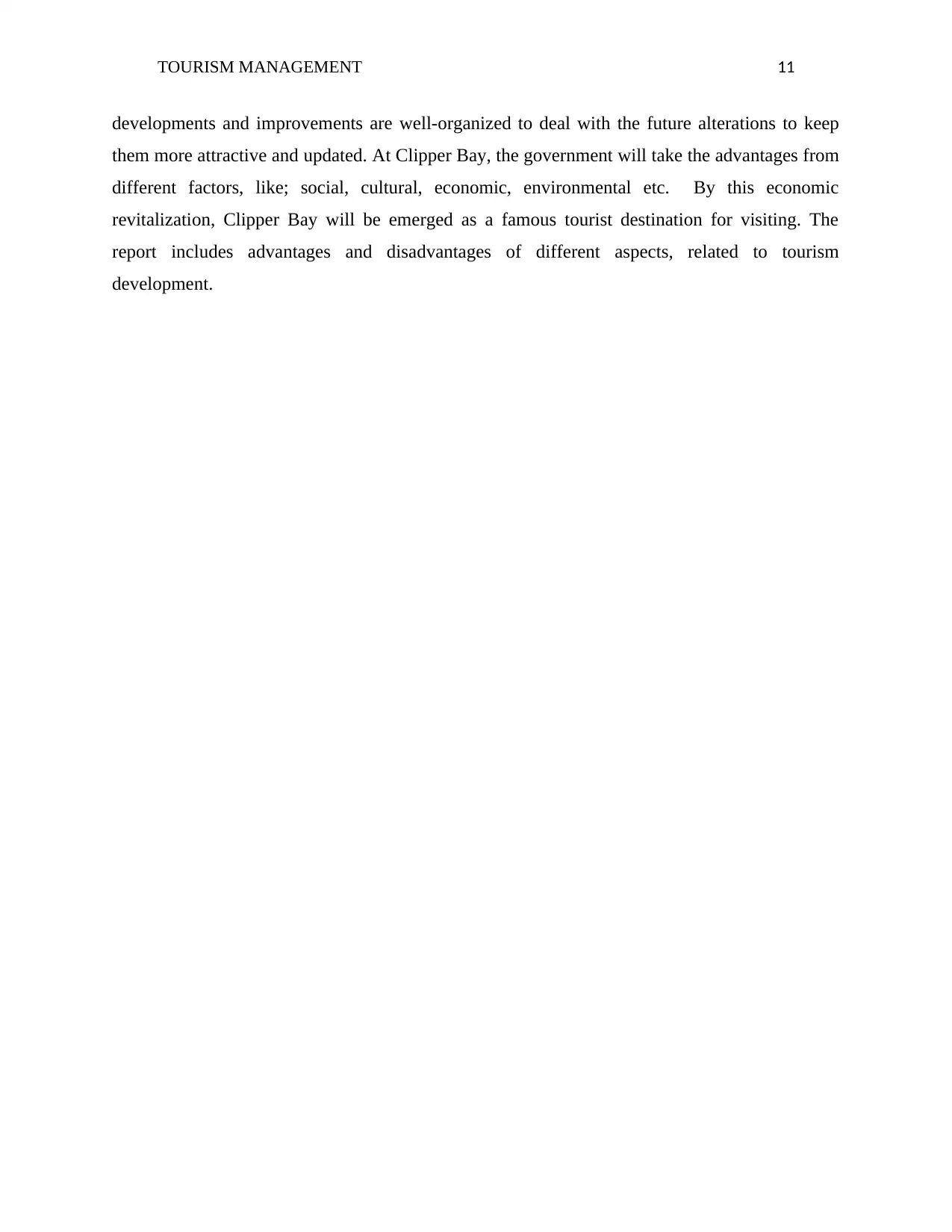
TOURISM MANAGEMENT 11
developments and improvements are well-organized to deal with the future alterations to keep
them more attractive and updated. At Clipper Bay, the government will take the advantages from
different factors, like; social, cultural, economic, environmental etc. By this economic
revitalization, Clipper Bay will be emerged as a famous tourist destination for visiting. The
report includes advantages and disadvantages of different aspects, related to tourism
development.
developments and improvements are well-organized to deal with the future alterations to keep
them more attractive and updated. At Clipper Bay, the government will take the advantages from
different factors, like; social, cultural, economic, environmental etc. By this economic
revitalization, Clipper Bay will be emerged as a famous tourist destination for visiting. The
report includes advantages and disadvantages of different aspects, related to tourism
development.

TOURISM MANAGEMENT 12
References
Antonio, E., Arora, K., Doehring, C., & Hernandez, A. (2014). Theological education and
economic revitalization: Creating sustainable organizations through authentic
engagement. Theological Education, 48(2), 57-67.
Ardahaey, F.T. (2011). Economic Impacts of Tourism Industry. International Journal of
Business andManagement, Vol. 6, No. 8, pp. 206-215.
Arch Daily. (2010). 36 Clipper Bay Home / FGR Architects. Retrieved from
http://www.archdaily.com/96431/36-clipper-bay-home-fgr-architects.
Briassoulis, H., & Van der Straaten, J. (Eds.). (2013). Tourism and the environment: regional,
economic, cultural and policy issues (Vol. 6). Springer Science & Business Media.
Burayidi, M. A. (2013). Downtowns: revitalizing the centers of small urban communities.
Routledge.
Cárdenas-García, P. J., Sánchez-Rivero, M., & Pulido-Fernández, J. I. (2015). Does tourism
growth influence economic development?. Journal of Travel Research, 54(2), 206-221.
Coria, J. & Calfucura, E. (2012). Ecotourism and the development of indigenous communities:
The good, the bad, and the ugly. Ecological Economics, 73, 47–56.
Eusébio, C., Carneiro, M. J., Kastenholz, E., & Alvelos, H. (2016). The impact of social tourism
for seniors on the economic development of tourism destinations. European Journal of
Tourism Research, 12, 5.
Frey, N. & George, R. (2010). Responsible tourism management: the missing link between
business owners’ attitude and behavior in the cap town tourism industry. Tourism
Management, Vol. 31, No.5, pp.621-628.
George, E.W., Mair, H. & Reid, D.G. (2009). Rural Tourism Development: Localism and
Cultural Change. Channel View Publications.
Kim, H. J., Chen, M.H. & Shawn Jang, S. (2006). Tourism expansion and economic
development: The case of Taiwan. Tourism Management, No.27, p.925–933.
References
Antonio, E., Arora, K., Doehring, C., & Hernandez, A. (2014). Theological education and
economic revitalization: Creating sustainable organizations through authentic
engagement. Theological Education, 48(2), 57-67.
Ardahaey, F.T. (2011). Economic Impacts of Tourism Industry. International Journal of
Business andManagement, Vol. 6, No. 8, pp. 206-215.
Arch Daily. (2010). 36 Clipper Bay Home / FGR Architects. Retrieved from
http://www.archdaily.com/96431/36-clipper-bay-home-fgr-architects.
Briassoulis, H., & Van der Straaten, J. (Eds.). (2013). Tourism and the environment: regional,
economic, cultural and policy issues (Vol. 6). Springer Science & Business Media.
Burayidi, M. A. (2013). Downtowns: revitalizing the centers of small urban communities.
Routledge.
Cárdenas-García, P. J., Sánchez-Rivero, M., & Pulido-Fernández, J. I. (2015). Does tourism
growth influence economic development?. Journal of Travel Research, 54(2), 206-221.
Coria, J. & Calfucura, E. (2012). Ecotourism and the development of indigenous communities:
The good, the bad, and the ugly. Ecological Economics, 73, 47–56.
Eusébio, C., Carneiro, M. J., Kastenholz, E., & Alvelos, H. (2016). The impact of social tourism
for seniors on the economic development of tourism destinations. European Journal of
Tourism Research, 12, 5.
Frey, N. & George, R. (2010). Responsible tourism management: the missing link between
business owners’ attitude and behavior in the cap town tourism industry. Tourism
Management, Vol. 31, No.5, pp.621-628.
George, E.W., Mair, H. & Reid, D.G. (2009). Rural Tourism Development: Localism and
Cultural Change. Channel View Publications.
Kim, H. J., Chen, M.H. & Shawn Jang, S. (2006). Tourism expansion and economic
development: The case of Taiwan. Tourism Management, No.27, p.925–933.
⊘ This is a preview!⊘
Do you want full access?
Subscribe today to unlock all pages.

Trusted by 1+ million students worldwide
1 out of 13
Related Documents
Your All-in-One AI-Powered Toolkit for Academic Success.
+13062052269
info@desklib.com
Available 24*7 on WhatsApp / Email
![[object Object]](/_next/static/media/star-bottom.7253800d.svg)
Unlock your academic potential
Copyright © 2020–2025 A2Z Services. All Rights Reserved. Developed and managed by ZUCOL.





